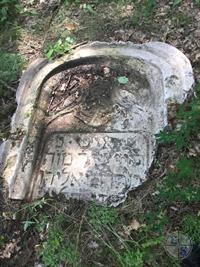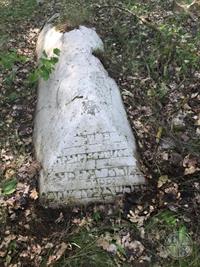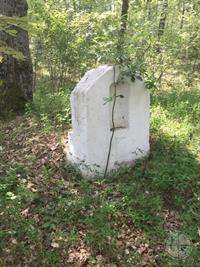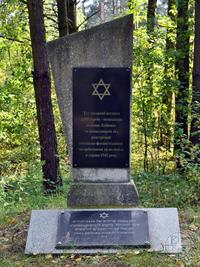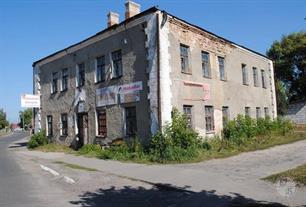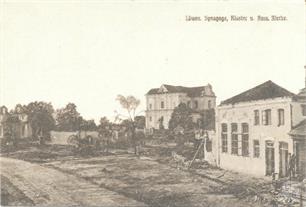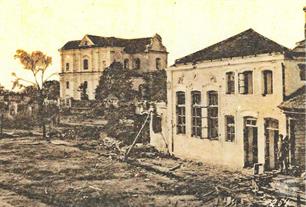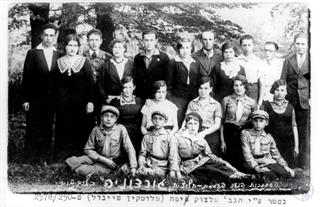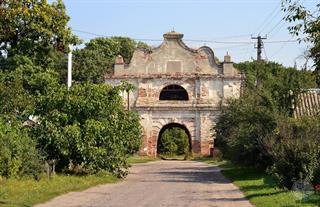Liubeshiv
Sources:
- Russian Jewish encyclopedia;
- Yad Vashem. Lubieszуw;
Photo:
- European Jewish Cemeteries Initiative. Liubeshiv Jewish Cemetery;
- Viacheslav Galievskyi, Wikipedia. Любешів
- FB Society Я ♥ Любешів
- Russian Jewish encyclopedia;
- Yad Vashem. Lubieszуw;
Photo:
- European Jewish Cemeteries Initiative. Liubeshiv Jewish Cemetery;
- Viacheslav Galievskyi, Wikipedia. Любешів
- FB Society Я ♥ Любешів
Urban -type settlement (since 1940), the former district center in the Volyn region.
Founded in 1484. In the middle of the 16th century he received Magdeburg law. In the 16–18 centuries - the township of Lyubishov in Pinsky powiat Brest Voivodeship as part of the Commonwealth. Since 1795 - as part of the Russian Empire. In the 19th - beginning of the 20th century - in the Pinsk district of the Minsk province. In 1919–39 - as part of Poland, in 1939–91 - the Ukrainian SSR.
In 1766, 385 Jews lived in Liubeshiv;
in 1847 - 831,
in 1886 - approx. 1800,
in 1897 - 1888 (70%),
in 1910 - 2171 (33.7%),
in 1914 - approx. 2000,
in 1936 - approx. 1500 Jews.
The first mention of the Jews of Liubeshiv dates back to the middle of the 17th century, when in 1648, at the time of Khmelnitchina, they managed to flee the city and escape.
In 1867, one synagogue acted.
In the 19th - beginning of the 20th century, the main areas of economic activity of Jews are small trade and crafts. In 1913, 5 shops belonged to Jews (including both manufactory), a shipping company.
4 synagogues acted at this time. The rabbis traditionally were representatives of the Wingarten family. In 1907–14, E.L. Klepfish (1878–?), at the beginning of the 20th century - M.M. Perlin, were a rabbis.
In 1912, a Jewish loan-saving society acted in Liubeshiv.
Founded in 1484. In the middle of the 16th century he received Magdeburg law. In the 16–18 centuries - the township of Lyubishov in Pinsky powiat Brest Voivodeship as part of the Commonwealth. Since 1795 - as part of the Russian Empire. In the 19th - beginning of the 20th century - in the Pinsk district of the Minsk province. In 1919–39 - as part of Poland, in 1939–91 - the Ukrainian SSR.
In 1766, 385 Jews lived in Liubeshiv;
in 1847 - 831,
in 1886 - approx. 1800,
in 1897 - 1888 (70%),
in 1910 - 2171 (33.7%),
in 1914 - approx. 2000,
in 1936 - approx. 1500 Jews.
The first mention of the Jews of Liubeshiv dates back to the middle of the 17th century, when in 1648, at the time of Khmelnitchina, they managed to flee the city and escape.
In 1867, one synagogue acted.
In the 19th - beginning of the 20th century, the main areas of economic activity of Jews are small trade and crafts. In 1913, 5 shops belonged to Jews (including both manufactory), a shipping company.
4 synagogues acted at this time. The rabbis traditionally were representatives of the Wingarten family. In 1907–14, E.L. Klepfish (1878–?), at the beginning of the 20th century - M.M. Perlin, were a rabbis.
In 1912, a Jewish loan-saving society acted in Liubeshiv.
Kamin-Kashyrskyy district, Volyn region
During World War I, with the withdrawal of the Russian army from the town, Cossacks burned it down.
German occupation forces who arrived in Lubieszуw expelled all of its Jewish population to the interior of Poland.
After World War I Kamień Koszyrski was incorporated into the independent Polish state. From 1924 Jews began to return to the town.
During the interwar years Liubeshiv's 1,500 Jews probably formed a majority of the town's population. They engaged in petty trade and crafts.
Jewish parties (Poalei Agudas Yisrael) and Zionist youth movements (Beitar, Ha shomer hadati, and Gordoniya) were active in the community.
The Jewish library worked.
German occupation forces who arrived in Lubieszуw expelled all of its Jewish population to the interior of Poland.
After World War I Kamień Koszyrski was incorporated into the independent Polish state. From 1924 Jews began to return to the town.
During the interwar years Liubeshiv's 1,500 Jews probably formed a majority of the town's population. They engaged in petty trade and crafts.
Jewish parties (Poalei Agudas Yisrael) and Zionist youth movements (Beitar, Ha shomer hadati, and Gordoniya) were active in the community.
The Jewish library worked.
In September 1939, with the arrival of the Red Army in the town following the Ribbentrop-Molotov Pact, Liubeshiv became part of Soviet Ukraine. During this period some refugees from Nazi-occupied Poland fled to the town.
The Germans captured Liubeshiv on June 29, 1941. Shortly after the beginning of the occupation, local Ukrainian nationalists gained control of the town and carried out a pogrom. Many Jews were robbed and several were killed. In reaction local Jews organized a self-defense group. At the end of July 1941, outside the town, near Sudcze village an SS unit shot to death several dozen Jewish men (including the rabbi of the town - Rabbi Yitzhak Aron Weingarten), who were accused of having collaborated with the Communists. In the summer and fall of 1941 the German authorities implemented a number of discriminatory measures against the Jews. They forced them to wear white armbands with the Star of David (subsequently replaced by yellow patches on their clothes); the Jews also had to perform forced labor, such as cleaning, and loading wood at the railway station. In late September 1941, on the orders of the Gebietskommissar (regional commissar) of Kamień Koszyrski Fritz Michaelis a six-member Jewish council was established, along with a Jewish police force. Between July 1941 and February 1942 the Jewish community was subjected to a series of demands for money.
In early May 1942 the Gebietskommissar ordered the creation of a ghetto (enclosed by a tall fence topped with barbed wire), into which all the Jews of the town and the surrounding villages of Liubeshiv County were forced. It is estimated that approximately 2,000 Jews were confined in the ghetto.
In August 1942 the Germans conducted murder operations in different locations. During the selection that was had carried out on the ghetto's square several hundred Jews were shot to death while trying to escape from a synagogue where they had been held. Several hundred others were shot to death in two other locations - near the village of Sudcze and near the village of Wуlka-Lubiesziwska (Volya-Liubashivska). Apparently during this period of time a group of Jewish men was taken to build a bridge over the Prypyat River near the village of Lubiaż. After the bridge was completed, all of them were shot to death at the site.
Along with their families, several dozen Jewish craftsmen who had been spared during the selection and taken back to the ghetto were soon joined by most of the approximately 200 Jews who had escaped but whom the Ukrainian police had succeeded in rounding up. The ghetto was liquidated in November 1942, when its last inmates were shot to death inside the ghetto near the town's synagogue.
The Germans captured Liubeshiv on June 29, 1941. Shortly after the beginning of the occupation, local Ukrainian nationalists gained control of the town and carried out a pogrom. Many Jews were robbed and several were killed. In reaction local Jews organized a self-defense group. At the end of July 1941, outside the town, near Sudcze village an SS unit shot to death several dozen Jewish men (including the rabbi of the town - Rabbi Yitzhak Aron Weingarten), who were accused of having collaborated with the Communists. In the summer and fall of 1941 the German authorities implemented a number of discriminatory measures against the Jews. They forced them to wear white armbands with the Star of David (subsequently replaced by yellow patches on their clothes); the Jews also had to perform forced labor, such as cleaning, and loading wood at the railway station. In late September 1941, on the orders of the Gebietskommissar (regional commissar) of Kamień Koszyrski Fritz Michaelis a six-member Jewish council was established, along with a Jewish police force. Between July 1941 and February 1942 the Jewish community was subjected to a series of demands for money.
In early May 1942 the Gebietskommissar ordered the creation of a ghetto (enclosed by a tall fence topped with barbed wire), into which all the Jews of the town and the surrounding villages of Liubeshiv County were forced. It is estimated that approximately 2,000 Jews were confined in the ghetto.
In August 1942 the Germans conducted murder operations in different locations. During the selection that was had carried out on the ghetto's square several hundred Jews were shot to death while trying to escape from a synagogue where they had been held. Several hundred others were shot to death in two other locations - near the village of Sudcze and near the village of Wуlka-Lubiesziwska (Volya-Liubashivska). Apparently during this period of time a group of Jewish men was taken to build a bridge over the Prypyat River near the village of Lubiaż. After the bridge was completed, all of them were shot to death at the site.
Along with their families, several dozen Jewish craftsmen who had been spared during the selection and taken back to the ghetto were soon joined by most of the approximately 200 Jews who had escaped but whom the Ukrainian police had succeeded in rounding up. The ghetto was liquidated in November 1942, when its last inmates were shot to death inside the ghetto near the town's synagogue.

- Home
- Shtetls
- Vinnytsia region
- Volyn region
- Dnipro region
- Donetsk region
- Zhytomyr region
- Zakarpattia region
- Zaporizhzhia region
- Ivano-Frankivsk region
- Kyiv region
- Kropyvnytskyi region
- Luhansk region
- Lviv region
- Mykolayiv region
- Odessa region
- Poltava region
- Rivne region
- Sumy region
- Ternopil region
- Kharkiv region
- Kherson region
- Khmelnytskyi region
- Chernihiv region
- Chernivtsi region
- Cherkasy region
- Crimea
- Synagogues
- Cemeteries
- Objects & guides
- Old photos
- History
- Contact
Jewish towns of Ukraine
My shtetl
My shtetl
Donate
Jewish towns of Ukraine
